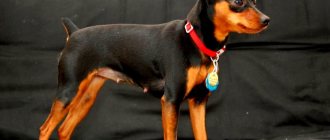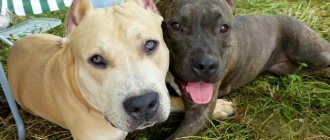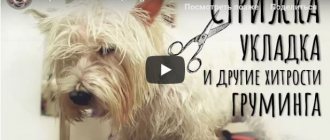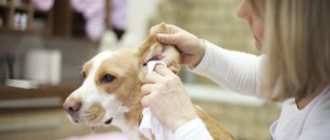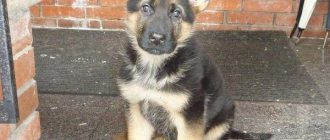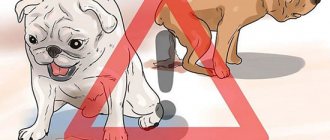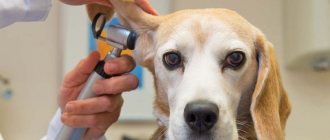Are there any indications?
Previously, cropping a pit bull's ears was mandatory, since this was how the owner protected the pet from damage during fights. An opponent can grab the long ears, disorienting the dog and causing other damage that cannot be defended against.
Now this operation is carried out to emphasize the breed. There is no benefit or harm to the dog from this. In rare cases, pit bull terriers protect residential and industrial facilities from forest predators. Then the dogs' ears are cropped for their own safety.
Medical indications for surgery:
- necrosis of the ears;
- injuries that cannot be treated;
- neoplasms;
- ulcers.
In Europe, it has long been prohibited to operate on dogs in pursuit of conformation, considering such a procedure inhumane. If you cropped a pit bull’s ears, this will only be treated normally at exhibitions in the CIS countries, and at international competitions the judges will lower the score.
Are there any contraindications
If the owner decides to trim the ears of a pit bull, one should remember the cases when the operation cannot be performed or should be postponed.
Contraindications may be:
- serious physical and mental defects in the puppy;
- discharge from the ears of an unknown nature;
- age over 6 months.
Important! Adult dogs' ears are cropped only for medical reasons, as they may heal improperly.
Timing for surgery
Pit bulls have their ears cropped at 1-2 weeks of age. During this period, the nerves in this area do not work at full strength, so the puppy does not feel as much pain. Sometimes breeders want to crop a pit bull's ears and tail at the same time so as not to stress the dog twice. The blood vessels are also not fully developed, so the puppy literally gets off with little blood. However, this breed does not have its tail docked.
Some veterinarians believe that the operation should be performed between 2 and 3 months, before the formation of baby teeth and after the first preventive vaccination. This is dictated by the fact that while the puppy is small, it is difficult to predict his appearance as an adult. Cut off ears may look different as your pit bull gets older.
Adult dogs are operated on only for medical reasons. Even those who are chasing the exterior do not decide on such a procedure when the animal has grown up, since there is a high risk of formation of seals and scars at the site of the cuts.
How does the price work out?
The cost of the operation depends on several factors:
- level and authority of the veterinarian, clinic;
- age of the animal;
- the anesthetic drug used.
The average price is 500 – 3000 rubles. At home – 500-1000 rubles more expensive.
READ Kurzhaar education training character
The cost of ear cropping does not depend on the breed or shape chosen. The age of the animal influences - puppies are operated on for 500-1000 rubles, adult dogs - for 2000-3000 rubles. The cost of anesthesia and home visits may be added to the total amount. Different clinics have their own price list, so you need to find out the cost on the spot.
Operation stages
First, the veterinarian measures the dog's ears and determines the location of the cartilage. You can attach templates with different shapes to see which one looks best. The dog is weighed and put under anesthesia.
Each ear is treated in turn with an antiseptic, then cut from the outer edge to the inner according to the intended shape. The cut is disinfected, a suture is placed on it, and the wound is bandaged. Many veterinarians ask owners to be present during surgery so that the puppy feels protected and supported.
It is important that the seam is located only on the skin and not on the cartilage. Otherwise, as healing progresses, the shape of the ears will become deformed, and complications are possible.
The procedure can be carried out at home. The Pit Bull Terrier will feel more confident and comfortable. To do this, you need to call a veterinarian to your home and provide sterile conditions. The ear trimming procedure lasts no more than 5-10 minutes.
Procedure for the cupping operation
The operation lasts about half an hour, maximum – up to one and a half hours.
READ How cats are euthanized in veterinary clinics
The dog is secured with straps on the operating table. They put a muzzle on her. The owner must additionally ensure that the animal does not twitch.
The hair around the ears is cut off and the skin is treated with an antiseptic. Then anesthesia is given. Puppies' ears are trimmed under local anesthesia. For an adult dog, general anesthesia is required.
The procedure is carried out with the following tools:
- surgical scissors;
- clamps;
- pattern for precision cutting.
After trimming, if there is no bleeding, everything went well, the clamps are removed, the edges of the wounds are sutured and treated with an antiseptic. Instead of seams, special glue can be used.
Cupping can be done at home, with a veterinarian visiting. The procedure is similar, but costs more. It is important to choose a professional veterinarian and keep your home clean.
Form options
In pit bulls, the ears are set high, so when docking, only 1/3 of the original length is left. The following options are acceptable for this breed:
- Long. The operation is not performed; a pit bull with undocked ears looks less menacing.
- Exhibition. Only 1/3 of the part is cut off and given a characteristic shape with a corner bent inward.
- Short. Leave only half the total length or a little less.
- Fighting ones. Almost the entire length of the ear is cut off, leaving short shells.
Pit bull terriers need to have their ears cropped correctly as they can fall over their head. The procedure is carried out by the owner himself after the stitches are removed. A regular patch is used to secure the desired position.
The ear is carefully pulled to the side by the tip and fixed in the desired position with your fingers. The patch is glued just below the crease, closer to the base, and wound in a clockwise direction. In the same way, the second piece is glued a little lower. At the end, the entire structure is secured - the ear is pulled up with one hand, and the patch is sealed with the other.
Medical indications for cupping
In the vast majority of cases, ear cropping in dogs is carried out at the request of the owner. The owner wants to give the pet a special look and undergoes surgery. After ear cropping, dogs begin to be perceived as threatening, faster, and simply more familiar.
But there are a number of medical indications for amputation of the auricle:
- – serious wounds, other mechanical damage;
- – multiple profuse non-healing ulcers;
- – necrosis of various types;
- – burns;
- – neoplasms.
If everything is fine with the ears, but the owner has firmly decided to change the pet’s appearance, it is necessary to consult with a veterinarian about the operation and recovery of the dog after it.
Rehabilitation period
After surgery, the pit bull is given a plastic collar to prevent the stitches from licking and causing infection. If the puppy feeds on its mother's milk, then she will have to be isolated for a while. It is necessary to bring a small pit bull terrier to her only for feeding time. Its bedding must be changed regularly to prevent bacteria from entering the wounds.
Every day, the seams must be treated with an antiseptic. If an unknown fluid is released from the wounds, or the skin around them is red or inflamed, then you should immediately consult a veterinarian.
The dog's head should remain bandaged for the first few days. If the puppy is old enough, your veterinarian may prescribe pain medications. Once the stitches are removed, you need to massage your pit bull's ears every day, gently pulling the tips with your fingers.
Pitbull puppy, 4 months old, ear cropping.
Introduction
To undergo practical training, I, Alena Aleksandrovna Chekmareva, student of group 605/1, was sent to the city veterinary department. The department is located in the city of Bishkek, on Orozbekova street 253, crossing Shcherbakova street. Upon arrival, I listened to a lecture on the structure of management work. Also, they explained to me in general the work of veterinarians in the city and all the responsibility for maintaining the safety of the phytosanitary situation. There was also a short tour of the management area, a two-story building. The administrative part is located on the top floor.
And in the lower part there is the Central Veterinary Hospital (CVL), equipped with all the necessary equipment, but only outdated ones. The clinic staff receives animals, examines them, prescribes treatment, and performs operations.
The working day at the veterinary department starts at 8:30, ends at 1800, lunch is from 12 to 1300.
I work in a clinic and have two veterinarians. There is also a department for issuing certificates for the export of animals. I worked at the level of real employees. And I think that I showed my positive quality and everyone was happy with me. During my practice, not many operations were performed. One of them is Docking the Dog’s Ears and Tail. This is already a cosmetic operation. There are two different types of ear cropping: - Breeds with short cropped ears, this operation is performed on shepherd dogs. The operation must be carried out between birth and three days of age, but the sooner the better. Practice shows that it is better to carry out this procedure immediately after the birth of the puppies. Sometimes we crop the ears and tails right during the birth of the dog. In this case, bleeding and pain are much less.
Ear cropping.
The following breeds of dogs undergo ear or tail docking: Shorthaired Pointer, Giant Schnauzer, Doberman, Royal and Great Dane, Bulldog, Boxer, virtually all terriers (Yorkshire Terrier, Airedale Terrier, Cropped Welsh Terrier, Black Terrier, Fox Terrier, Jagdterrier). Tail/ear docking is also carried out on breeds such as spaniels (English cocker, Russian spaniel, American cocker, etc.), Staffordshire bull terrier, poodle, setter, miniature schnauzer, sharpei, canne corso and others. If a dog breeder’s immediate plans include purchasing a puppy whose breed exterior requires ear and/or tail docking, then he needs to know all the intricacies of the process - the optimal age for docking, methods of docking, complications that may arise after the procedure, as well as contraindications for its implementation. The definition of docking states that This is a surgical intervention on the ears or tail of a dog, carried out for therapeutic or cosmetic purposes.
Ear cropping requires preliminary preparation, namely:
10-12 hour fasting before surgery;
securely fixing the dog. The dog is placed on the table, the front legs are stretched forward, the hind legs are stretched back and carefully secured. Additionally, the dog’s body and jaw should be fixed;
hair removal. The future surgical site is cleaned of hair and treated with an antiseptic.
pain relief. Basically, during such operations, local anesthesia is used, with the exception of an adult dog - in this case, general anesthesia is administered.
Cropping a dog's ears or tail takes about 40-90 minutes and is virtually painless. The postoperative healing period is about two weeks.
Pitbull puppy, 4 months old, ear cropping.
A week after cupping.
Also, an operation was performed to amputate the 6th finger.
Dewclaws of the hind limbs are not considered a pathology and it is not necessary to remove them. Veterinarians recommend operating on puppies to avoid possible complications:
injuries while walking, running;
inconvenience in caring for the dog: cutting, combing; bathing;
ingrowth of the nail into the skin.
It is mandatory to remove a finger in case of diseases of the dog’s paws. Such diseases include:
necrosis – tissue death;
osteosarcoma;
gangrene;
osteomyelitis;
dewclaw injury.
There is also a group of dogs that will have to have their dewclaw removed:
Hunting breeds. Due to the rudiment, it becomes difficult to move through thickets and forests. The fifth finger will simply cling to branches and grass, which can injure the animal.
Show dogs. If a dog is being prepared for a show, then removal of the rudiment is mandatory during puppyhood. But there is an exception: it is forbidden for the Pyrenean Mountain Dog and Biard to remove the rudiment before the exhibition. The appearance of the 5th finger indicates their purebred.
To reduce the risk of injury, veterinarians recommend removing dewclaws from puppies under one week of age. During this period, the puppy will not feel severe pain, and the recovery process will go quickly.
How does amputation occur?
Some dog owners, instead of seeking professional help, carry out the amputation themselves. But it would seem that the simplest operation can only harm the puppy: the owner will simply remove the rudiment incorrectly and in adulthood the pet will have to resort to removing the dewclaw again. If amputation is carried out without pain relief, the puppy will develop pain shock and the animal may die. Also, the puppy may develop an allergic reaction to the anesthesia; due to swelling of the larynx, the pet may die.
Veterinarians recommend removing the fifth toe in puppies when the risk of complications is minimal. A one-week-old puppy has a weak pain threshold, so amputation of the dewclaw is easier to tolerate than in adult dogs. The operation is performed under local anesthesia or general anesthesia, depending on the age of the pet. Surgical intervention is easily tolerated and does not pose a threat to the life of the animal. In adult dogs, the rudiment is removed after injury.
.
If the puppy did not have time to remove the rudiment before the age of one week, then the operation is postponed. In this case, the veterinarian will resort to surgical intervention when the dog reaches 12-16 weeks.
Progress of the operation
Removal of the 5th toe in puppies is carried out in a veterinary clinic where sanitary standards are observed. Before removing the vestige, the operating room is disinfected and instruments are sterilized. The course of the operation depends on the attachment of the rudiment:
If the rudiment is attached to the skin, the veterinarian removes it using scissors and a scalpel.
If the rudiment is connected to the bone by a phalanx, then the veterinarian will remove the second phalanx with a scalpel.
After the operation, the puppy may notice some bleeding. After stopping, the dog is given stitches and a sterile bandage. To prevent the puppy from developing stress, the doctor can sew the wound with self-absorbable threads - catgut.
Rehabilitation
After surgery to remove the 5th toe from a dog, the owner must carefully monitor the condition of the wound. The dog must be in a clean room where wet cleaning is carried out daily. Every other day you will have to change the bandage using antiseptic agents. Simple manipulations will protect your pet from infection through an open wound.
A week after the rudiment has been removed, the puppy needs to be shown to a veterinarian. If the stitches are applied with catgut, they will dissolve on their own. If the dog received stitches during the operation, then on the 8th day, after the manipulation, it will be done by specialists.
Care for dewclaws
If the breeder decides not to amputate the 5th finger of his pet, then he must properly care for him. All procedures are carried out in the same way as with the animal’s ordinary fingers: it is necessary to trim the claws in a timely manner and ensure that the dog does not injure the rudiment. But, if the claws grow incorrectly, dig into the skin, and cause discomfort to the dog, then veterinarians recommend thinking about the procedure for removing the dewclaw.
Whether or not to amputate a puppy's 5th toe is the owner's decision. Before making a decision, the owner should think about the animal’s lifestyle: whether the owner can care for the 5th toe without injury. Grooming, bathing or combing the animal should be done with extreme caution. An extra finger should not interfere with walks and exhibitions.
Possible complications
After surgery, severe bleeding may occur. It can be removed with veterinary powder or pencil. If it does not go away, you need to take the pit bull to the clinic.
If an infection occurs in a wound, then it is necessary to determine the type of pathogen and select a drug that acts specifically on this microorganism. To do this, tests are taken at the clinic.
If the dog is an adult, seals and scars may form on the cuts, which are clearly visible due to the short hair of pit bull terriers. Nothing can be done about this - you cannot subject the dog to the operation again, and the result will most likely be the same.
Postoperative care
On the first day, the puppy’s head must be bandaged to avoid excessive bleeding. When the bandages are removed, the ears are disinfected with a solution of brilliant green, and this is done daily. A protective collar is put on the dog.
While the specialist has not removed the stitches, the ears are gently massaged so that the skin does not wrinkle during healing. If your pit bull whines for a long time, your veterinarian may prescribe pain medication. Such drugs are necessary for adult animals. The stitches are removed by a specialist a week or 10 days after the operation.
If you need the puppy's ears to be erect, they are glued in a special way. Rollers are placed inside the ears and secured in a standing position.
Possible complications
Complications during cupping are the same as with any surgical intervention. It is necessary to keep the circumcision sites clean and constantly disinfect them to avoid infection.
It’s bad when a few days after the operation there is heavy bleeding - the dog needs to be shown to a specialist. In adult dogs, a typical complication is scars on the ears. Therefore, docking an adult pit bull terrier is quite rare.
Veterinarians' opinion
Tatyana, 37 years old, Orel
“Personally, I like pit bulls’ undocked ears better, but it all depends on the owner. Often dogs of this breed are bought by young guys who want their pet to look menacing. In fact, pittas with ears feel more comfortable, as noted by breeders.”
Regina, 41 years old, Saratov
“I don’t understand the fashion for docking at all, even though I have to do it. Nature gave your dog beautiful ears that perform specific functions. Why put your pet under stress if only you will get mental satisfaction as a result?”
Origin story
At the end of the nineteenth century , when the baiting of large wild animals by dogs was officially prohibited, humanity was left without its favorite pastime and could not come to terms with it.
The cruel spectacle was replaced by a no less cruel spectacle, in which two fighting dogs performed in the ring. To create the ideal fighter, it was necessary to take the grip and pressure of a bulldog and the lightning speed of a terrier.
Pit bulls can be considered a more decorative version of the American Staffordshire Terrier.
As for aggression towards a person, this can really be achieved. It’s not for nothing that fighting dogs are prohibited in some civilized countries of the world. But we are talking specifically about upbringing; puppies do not have innate aggression. That is why in the USA, after the ban on dog fighting, strict monitoring was carried out over the reproduction and training of fighting breeds. Their numbers should have been reduced so that those left idle, prepared for merciless animal fights, would not be used as weapons against people .
The public was actively involved for this purpose. The media published articles about pit bulls attacking a person and his aggressive behavior. Thus, demand was reduced and numbers were reduced.
For more than a century, professional breeders carefully checked born puppies for aggressiveness. If he showed aggression to a greater extent than is allowed by the norms, then he was destroyed.
The man struggled with the fighting qualities of the creature he himself had created. Today, breeders claim that with proper upbringing, their pets pose no danger at all. They are loyal to their owner and can even be good nannies for children. But we should not forget that trusting an animal will be a person’s mistake, but not the beast’s misconduct.
Today, the talents of American fighters are used for the benefit of people. They serve in law enforcement agencies of many countries around the world, including the USA, CIS countries and Russia. They have an excellent sense of smell and are able to accurately determine the location of drugs.

